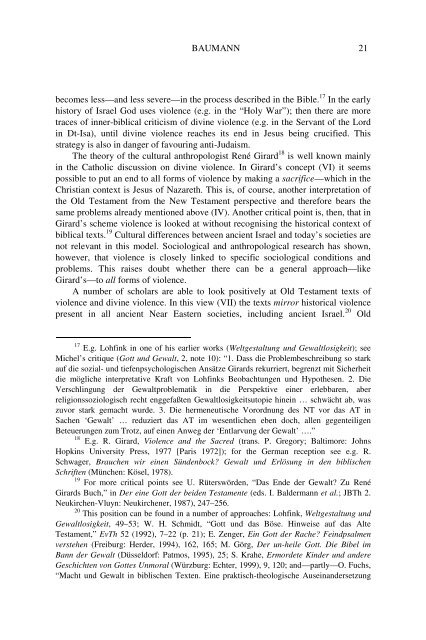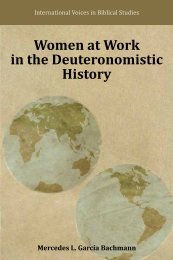Global Hermeneutics? - International Voices in Biblical Studies ...
Global Hermeneutics? - International Voices in Biblical Studies ...
Global Hermeneutics? - International Voices in Biblical Studies ...
Create successful ePaper yourself
Turn your PDF publications into a flip-book with our unique Google optimized e-Paper software.
BAUMANN 21<br />
becomes less—and less severe—<strong>in</strong> the process described <strong>in</strong> the Bible. 17 In the early<br />
history of Israel God uses violence (e.g. <strong>in</strong> the “Holy War”); then there are more<br />
traces of <strong>in</strong>ner-biblical criticism of div<strong>in</strong>e violence (e.g. <strong>in</strong> the Servant of the Lord<br />
<strong>in</strong> Dt-Isa), until div<strong>in</strong>e violence reaches its end <strong>in</strong> Jesus be<strong>in</strong>g crucified. This<br />
strategy is also <strong>in</strong> danger of favour<strong>in</strong>g anti-Judaism.<br />
The theory of the cultural anthropologist René Girard 18 is well known ma<strong>in</strong>ly<br />
<strong>in</strong> the Catholic discussion on div<strong>in</strong>e violence. In Girard’s concept (VI) it seems<br />
possible to put an end to all forms of violence by mak<strong>in</strong>g a sacrifice—which <strong>in</strong> the<br />
Christian context is Jesus of Nazareth. This is, of course, another <strong>in</strong>terpretation of<br />
the Old Testament from the New Testament perspective and therefore bears the<br />
same problems already mentioned above (IV). Another critical po<strong>in</strong>t is, then, that <strong>in</strong><br />
Girard’s scheme violence is looked at without recognis<strong>in</strong>g the historical context of<br />
biblical texts. 19 Cultural differences between ancient Israel and today’s societies are<br />
not relevant <strong>in</strong> this model. Sociological and anthropological research has shown,<br />
however, that violence is closely l<strong>in</strong>ked to specific sociological conditions and<br />
problems. This raises doubt whether there can be a general approach—like<br />
Girard’s—to all forms of violence.<br />
A number of scholars are able to look positively at Old Testament texts of<br />
violence and div<strong>in</strong>e violence. In this view (VII) the texts mirror historical violence<br />
present <strong>in</strong> all ancient Near Eastern societies, <strong>in</strong>clud<strong>in</strong>g ancient Israel. 20 Old<br />
17 E.g. Lohf<strong>in</strong>k <strong>in</strong> one of his earlier works (Weltgestaltung und Gewaltlosigkeit); see<br />
Michel’s critique (Gott und Gewalt, 2, note 10): “1. Dass die Problembeschreibung so stark<br />
auf die sozial- und tiefenpsychologischen Ansätze Girards rekurriert, begrenzt mit Sicherheit<br />
die mögliche <strong>in</strong>terpretative Kraft von Lohf<strong>in</strong>ks Beobachtungen und Hypothesen. 2. Die<br />
Verschl<strong>in</strong>gung der Gewaltproblematik <strong>in</strong> die Perspektive e<strong>in</strong>er erlebbaren, aber<br />
religionssoziologisch recht enggefaßten Gewaltlosigkeitsutopie h<strong>in</strong>e<strong>in</strong> … schwächt ab, was<br />
zuvor stark gemacht wurde. 3. Die hermeneutische Vorordnung des NT vor das AT <strong>in</strong><br />
Sachen ‘Gewalt’ … reduziert das AT im wesentlichen eben doch, allen gegenteiligen<br />
Beteuerungen zum Trotz, auf e<strong>in</strong>en Anweg der ‘Entlarvung der Gewalt’ ….”<br />
18 E.g. R. Girard, Violence and the Sacred (trans. P. Gregory; Baltimore: Johns<br />
Hopk<strong>in</strong>s University Press, 1977 [Paris 1972]); for the German reception see e.g. R.<br />
Schwager, Brauchen wir e<strong>in</strong>en Sündenbock? Gewalt und Erlösung <strong>in</strong> den biblischen<br />
Schriften (München: Kösel, 1978).<br />
19 For more critical po<strong>in</strong>ts see U. Rüterswörden, “Das Ende der Gewalt? Zu René<br />
Girards Buch,” <strong>in</strong> Der e<strong>in</strong>e Gott der beiden Testamente (eds. I. Baldermann et al.; JBTh 2.<br />
Neukirchen-Vluyn: Neukirchener, 1987), 247–256.<br />
20 This position can be found <strong>in</strong> a number of approaches: Lohf<strong>in</strong>k, Weltgestaltung und<br />
Gewaltlosigkeit, 49–53; W. H. Schmidt, “Gott und das Böse. H<strong>in</strong>weise auf das Alte<br />
Testament,” EvTh 52 (1992), 7–22 (p. 21); E. Zenger, E<strong>in</strong> Gott der Rache? Fe<strong>in</strong>dpsalmen<br />
verstehen (Freiburg: Herder, 1994), 162, 165; M. Görg, Der un-heile Gott. Die Bibel im<br />
Bann der Gewalt (Düsseldorf: Patmos, 1995), 25; S. Krahe, Ermordete K<strong>in</strong>der und andere<br />
Geschichten von Gottes Unmoral (Würzburg: Echter, 1999), 9, 120; and—partly—O. Fuchs,<br />
“Macht und Gewalt <strong>in</strong> biblischen Texten. E<strong>in</strong>e praktisch-theologische Ause<strong>in</strong>andersetzung




